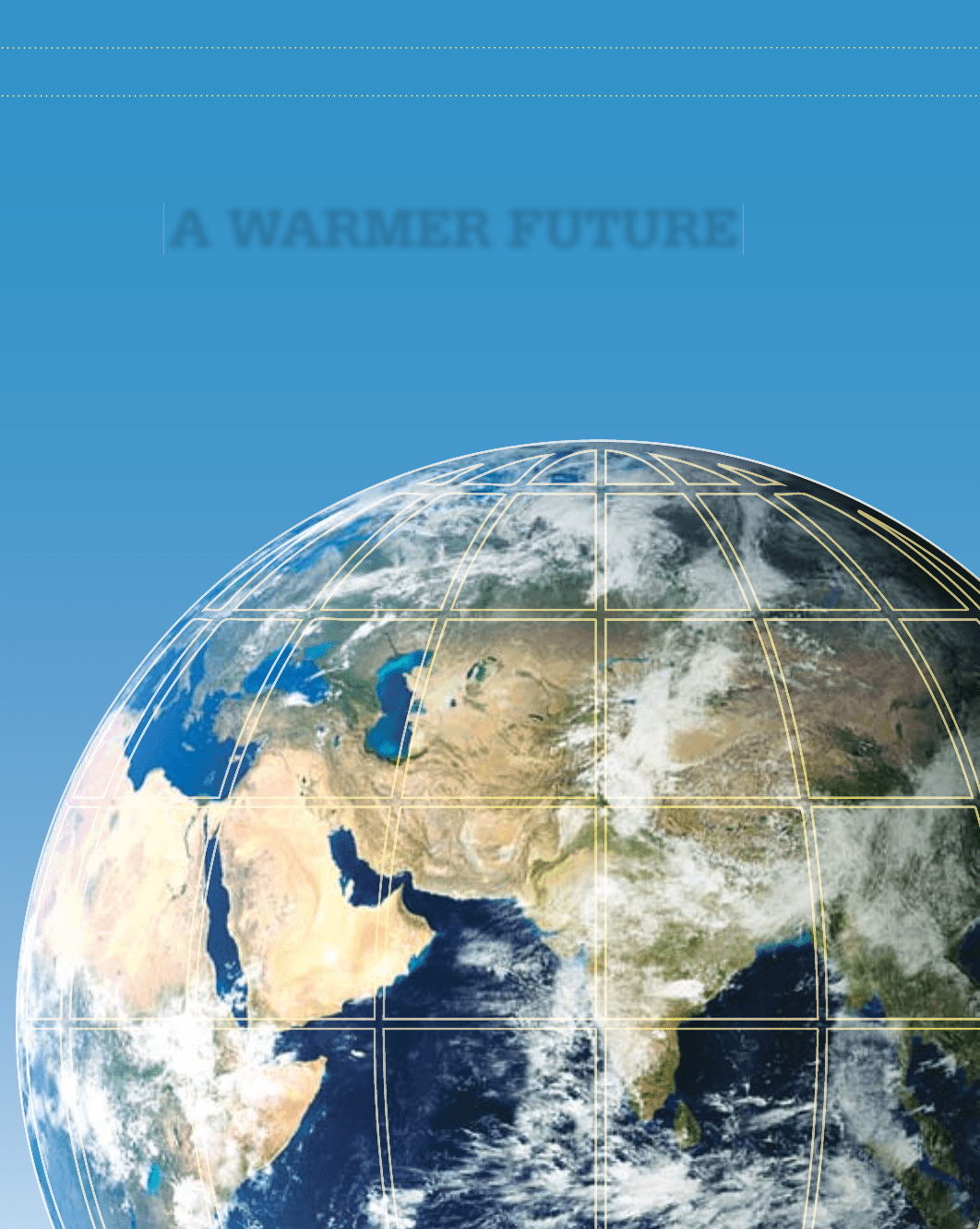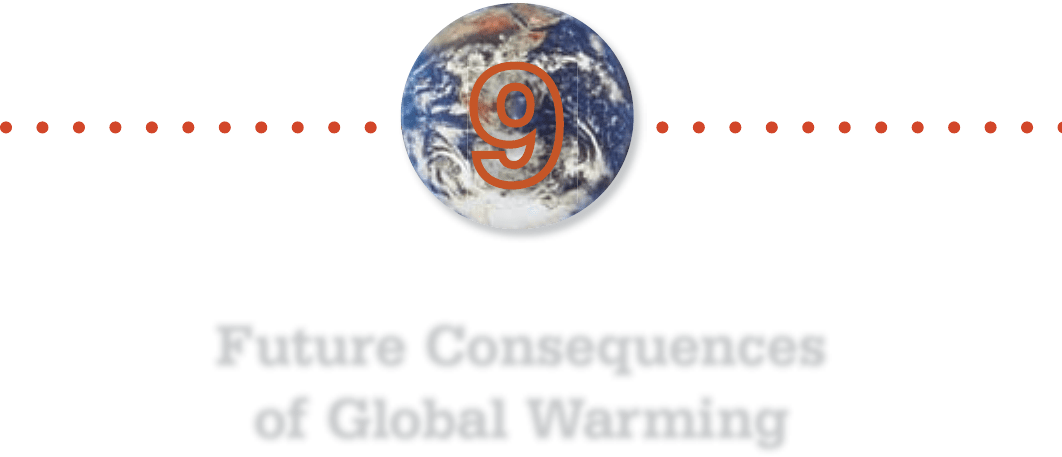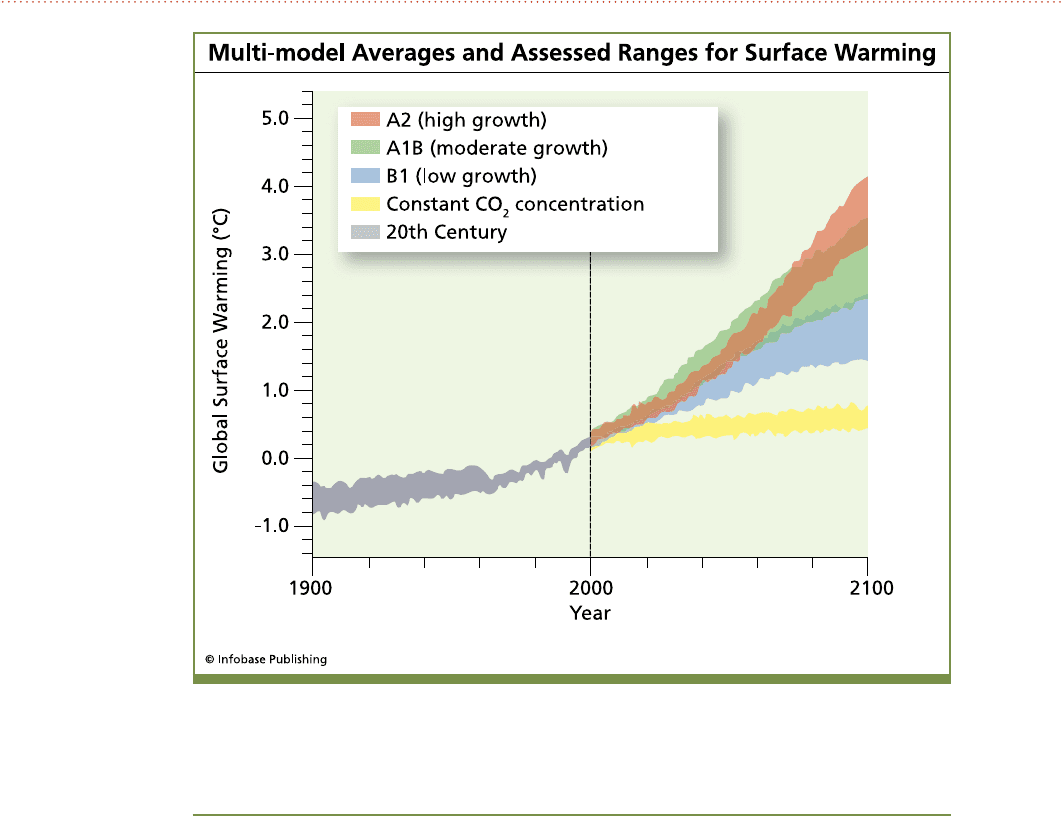Desonie D. Climate
Подождите немного. Документ загружается.


Climate
106
increased spring and summer temperatures and earlier snowmelt.
Similar changes in wildfire increases have been seen in other parts of
the Americas.
Wrapup
The effects of climate change are already apparent in living systems.
Plants and animals are changing their ranges and the timing of their
life cycles. As a result, some populations have expanded, some have
decreased, and some have just shifted. If these strategies do not work,
the organisms will die out locally, or the species may even become
extinct. The loss of a species that is important in a food web, such as
krill, can have repercussions throughout an ecosystem. The conse-
quences of warming that have been seen so far are just the beginning
of the changes that are predicted to come as temperatures continue
to rise.

A WARMER FUTURE
PART THREE

t
he scientific consensus is that global warming is now under
way. It is now necessary to determine how much, when, and
what the consequences will be. As Dr. Robert Watson, then
Chairman of the Intergovernmental Panel on Climate Change (IPCC),
said in 2001, “The overwhelming majority of scientific experts, whilst
recognizing that scientific uncertainties exist, nonetheless believe that
human- induced climate change is already occurring and that future
change is inevitable.”
With the use of climate models, scientists are attempting to develop
scenarios that predict the magnitude and timing of climate change.
future Climate models
To understand future climate scenarios, scientists construct complex
climate models. Good climate models take into account paleoclimate
data, thermal inertia, the effects of oceanic and atmospheric currents,
and the cooling effects of sulfate aerosols, among many other factors.
Future Consequences
of Global Warming
109
9

Climate
110
Complex models require the use of very powerful computers to make
these calculations.
Climate models have many uncertainties: Among the most impor-
tant of them is the difficulty of predicting how humans will behave in
the future. The models cannot predict, for example, how much carbon
people will emit into the atmosphere. Will CO
2
emissions increase at
the same rate they have for the past decade? Or will they increase at
an even higher rate due to improvements in lifestyles in the develop-
ing world (and even further improvements in the developed world)?
Or might they decrease due to conscious changes in lifestyle or tech-
nology? Because human behavior is unpredictable, climatologists
construct models using different estimates for these numbers, ranging
from conservative to extreme. For example, a climatologist might input
an annual reduction in carbon emissions into a conservative model or
allow CO
2
emissions to grow rapidly using an extreme model. After the
calculations are made, the results will be very different.
Models of future climate look at the effects on the Earth’s system
of various increases in greenhouse gas levels or in temperature. The
simplest of them are called commitment models, which predict the
responses that are inevitable due to greenhouse gases that have already
been added to the atmosphere. A commitment model predicts the
amount of warming that will occur as thermal inertia is overcome, even
if people stop adding greenhouse gases to the atmosphere. For example,
the temperature commitment for greenhouse gases released as of 2000
is a rise of between 0.9° and 1.8°F (0.5° and 1.0°C) by 2100. Com-
mitment models are extremely unrealistic because they assume that
people will immediately cease emitting greenhouse gases. Their value
is in providing a baseline picture of the inevitable changes to come.
Many models of future climate assume that greenhouse gas levels
will be stabilized at a temperature or a CO
2
level that society chooses.
These models require that people choose a value and actively reduce
greenhouse gas emissions to reach it. Some modelers use a doubling
of atmospheric CO
2
from its preindustrial value of 280 ppm. A recent
report says that a CO
2
value of 560 ppm will cause average global
temperature to rise up to 5°F (2.8°C).

111
The doubling model does not take time into account, so there is
no time frame for when this doubling will occur. To determine when
this CO
2
level will be reached, a rate of change of CO
2
values must
be figured into the model. One commonly used rate of change is an
increase in CO
2
by an extra 1% per year. In this model, CO
2
doubles
over preindustrial values by about 2080. Indeed, a value of 560 ppm
CO
2
by 2080 is not unlikely.
The business-as-usual model assumes that emissions will rise
along the same trajectory they have been on for the past decade, and
that there will be no efforts to reduce greenhouse gas emissions. At
this rate, CO
2
emissions in 2015 will be 35% greater than they were in
2000, and in 2030 they will be 63% greater than they were in 2002.
T
he business-as-usual model results in CO
2
levels over 600 ppm and
a temperature increase of 0.9 to 3.6°F (0.5 to 2°C) by 2050. (Thermal
inertia would keep the temperature from rising higher.) By 2100, CO
2
could reach 880 to 1,000 ppm, a level not seen for at least 30 million
years, with a certain temperature rise of between 3.5 and 8°F (2 and
4.5°C) and a 10% chance of an even greater rise.
Most models stop at the year 2100 or at a doubling of CO
2
, but
one business-as-usual model by scientists at the Lawrence Livermore
Laboratory in California was allowed to run out to 2300. This model
calculated what would happen if people continued to use fossil fuels
until the Earth’s entire supply was exhausted. The model run began in
1870 and predicted a fairly accurate increase in temperature of 1.4°F
(0.8°C) by 2000. By 2300, there was a quadrupling of CO
2
levels
from preindustrial to 1,423 ppm, and global surface temperatures were
14.5°F (7.8°C) higher than today. Land and polar areas warmed more,
with the most extreme warming of more than 36°F (20°C) taking place
over the Arctic. The oceans absorbed a great deal of CO
2
and became
more acidic, with the potential of harming marine life. As seawater
temperature surged, much of the ocean’s dissolved CO
2
was driven
back into the atmosphere, which further enhanced warming. The
m
ost drastic changes came in the twenty-second century, when green-
house gas emissions rates were the highest and the environmental
changes—in precipitation, extent of sea ice, and other features—were
Future Consequences of Global Warming

Climate
112
the greatest. Ice and tundra gave way to forests, and Northern Hemi-
sphere sea ice cover disappeared almost completely by 2150.
The study’s lead author, Govindasamy Bala, recognizes some weak-
nesses in the model but says that correcting the weaknesses would
actually make the situation more drastic. The model assumes that soil
and living biomass on land are carbon sinks but does not take into
account a few factors such as the clearing of forests. In a 2006 press
release about his study, Bala said, “We definitely know we are going
to warm over the next 300 years. In reality, we may be worse off than
we predict.”
In the alternative scenario, people quickly and severely limit
greenhouse gas emissions. CO
2
emissions level off by the end of this
decade, slowly decline for a few decades, and begin to decrease rapidly
b
y mid-century. Depending on the magnitude of the greenhouse gas
emission reduction, this model predicts an increase of less than 2°F
(1.1°C) this century.
The models discussed above are global models, but local models
can be constructed as well. Global models leave out some very impor-
tant information. A good example is the effect of global warming on the
Arctic. A global average temperature increase of 5°F (2.8°C) means a
o
ne- or two-degree increase at the equator but a 12°F (6.7°C) increase
at the North Pole. This has profound implications for melting sea ice
and ice caps, for polar ecosystems, and for the climate system due to
the positive feedback of reduced albedo.
Global dimming may be a larger factor in the accuracy of climate
models than anyone realized until recently. Most climate models use
the link between CO
2
levels and past temperature to predict how tem-
perature will respond to future CO
2
levels. But scientists now say that
warming in recent decades has been partially counteracted by global
dimming. In that case, climate models consistently underestimate the
temperature effects of rising CO
2
if global dimming is reduced (due to
pollution reductions). For example, when a climate model that predicts
a 9°F (5°C) temperature increase by the end of the century has a reduc-
tion in global dimming factored in, the predicted temperature increase

113
rises to 18°F (10°C). Therefore, unless greenhouse gas emissions are
also curbed, a decrease in air pollution will increase global warming.
While the timing and magnitude of changes due to rising tem-
perature cannot be known with certainty, climatologists agree that all
models point in the same direction. Another point of agreement is that
climate change will not continue to be gradual; when thresholds are
broken, climate will change rapidly.
Different models of climate change predict different temperatures by 2100, depending
on whether or how much greenhouse gas emissions are restricted. The averages of
the different models are included in the gray area; the colored shading encompasses
projected growth ranges for the twenty-rst century.
Future Consequences of Global Warming

Climate
114
Climate ConsequenCes by temperature
The IPCC’s Fourth Assessment (IPCC-4) report, from 2007, shows the
responses that can be expected for various increases in temperature
above 1990 levels:
Up to 1.8°F (1°C): Some ecosystem shifts; most coral reefs
bleached; some increases in global agricultural production
potential, but reduced yields at lower latitudes; increases in
severe storms
From 1.8 to 3.6°F (1 to 2°C): About one-quarter of spe-
cies lost from current range; further increases in global
agricultural production potential but further yield reduc-
tion at lower latitudes; coastal flooding; increased water
stress in dry areas, with increased risk to human health;
increased frequency and intensity of drought; increased
heat waves
For 3.6 to 5.4°F (2 to 3°C): Most of tundra and about half
of boreal forest area disappears; about one-third of species
lost from current range; all coral reefs bleached; global
agricultural production potential peaks, bringing hunger
to populations in lower latitudes; 1 billion people become
water stressed
For 5.4 to 7.2°F (3 to 4°C): Global decreases in agricultural
production potential; large numbers additionally at risk of
h
unger; up to one-third of global population water stressed;
widespread deglaciation and disintegration of West Antarc-
tic Ice Sheet; further increased intensity and frequency of
fire, drought, and storms
For 7.2 to 9.0°F (4 to 5°C): Decreases in agricultural
production potential at higher latitudes, as well as further
decreases at lower latitudes; too expensive to protect many
areas from flooding; frequency of hot days much greater,
many locations very difficult to live in; weakening and shut-
down of some ocean currents, including Atlantic meridi-
onal overturning

115
For 9.0 to 10.8°F (5 to 6°C): Widespread species
extinction.
The following sections describe in more detail what climate models
predict for the future as temperature rises.
temperature patterns
Temperatures will rise as atmospheric greenhouse gas levels increase,
but temperature increases will lag behind greenhouse gas levels due to
thermal inertia. Temperatures will not increase uniformly around the
globe: Most lands will warm more than the oceans due to the thermal
inertia of the seas; the Northern Hemisphere will warm more than the
Southern because it is mostly land; and the polar regions will warm
much more than the rest of the planet due to the transition of ice to
liquid water.
Water CyCle
The water cycle will continue to intensify. Precipitation will decrease
in drier areas, including in many mid-continental areas, and increase
in wetter areas. Rainfall will decline in some locations in the sum-
mer, which will harm crop yields, increase forest fires, and increase
water stress. Currently, about 1.7 billion people live in countries
that are water stressed: By 2025, that number will likely grow to
5 billion. Droughts will become longer and fiercer, making many
marginal regions difficult or impossible to inhabit, including the
western United States, northern China, and southern Africa. Deserts
will become drier, and the Asian monsoon will be enhanced but will
likely become more variable.
arCtiC
The Arctic will continue to melt. As ice is lost, animals such as polar
bears and seals will become greatly reduced in number or will go
Future Consequences of Global Warming
